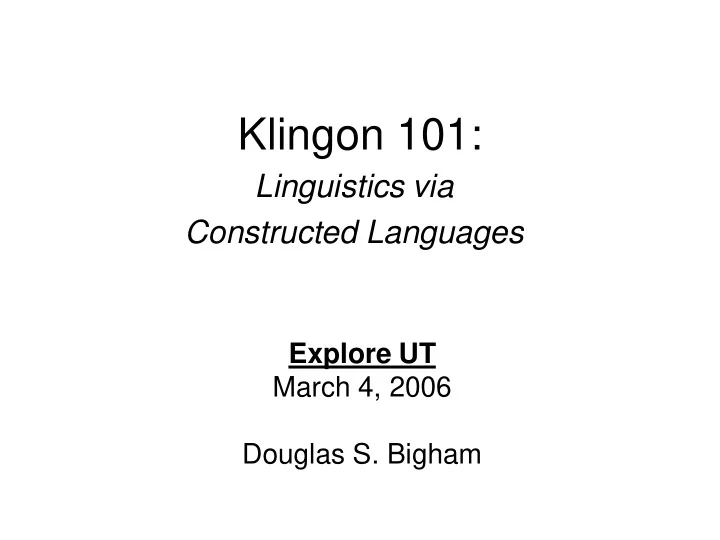

Klingon 101: Linguistics via Constructed Languages Explore UT March 4, 2006 Douglas S. Bigham
What is Linguistics? • Semantics/Lexicon • Word meaning • Phonetics/Phonology • Sounds • Morphology • Word building • Syntax • Making words into sentences • Sociolinguistics • The interaction of language and society
What is a Constructed Language? • Codes & Naming Languages • Morse code, Watership Down ’s “Lapine” • Most fictional languages are naming languages • Modified Natural Languages • Yodish • Fictional/Plot-driven Languages • Klingon, Vulcan, Láadan • Tolkien’s languages • Auxiliary Languages • Esperanto, Ido, Novial
So, how do these two fit? • The “four subfields” of linguistics are not easily separated in natural languages. • Constructed languages (ConLangs) allow each subfield to be addressed without the “noise” encountered in natural languages.
Course Layout • 2 sections: SWC and non-SWC • “Traditional” homeworks • Language exercises using Klingon and Esperanto • SWC: 3 short essay papers • Final project or research paper • Online homework • Discussion board on LiveJournal • Searching for new ConLangs • Created our own class ConLang • Class Participation • Large participation grade (15~20%)
Semantics ~ Codes & Naming Languages • Klingonaase (the other Klingon language) – John M. Ford’s The Final Reflection • Lingua Ignota – St. Hildegard von Bingen • Lapine, the Language of the Rabbits – Richard Adams’s Watership Down • embleer stinking • elil enemies • frith the sun (personified) • inle moonrise • hrair an uncountably large number • rah prince, leader, chief rabbit • Frithrah! An exclamation (lit. “The Lord Sun”)
Phonetics/Phonology & Writing • What do letters sound like? • Using the International Phonetic Alphabet (IPA)
• Klingonaase: • kh’ex :: corpse • kilaan :: unit of time • Gargish • Ultima game series, Origin Systems • Latin derived • Excellent orthography • p, b, m, f, v, u (across) • p, t, ch, kl, k (down)
Morphology • SolReSol • Only 7 syllables, based on musical scale – do, re, mi, fa, sol, la, si • Láadan – Speech Acts • Bíi :: declarative báa :: question • Bó :: command bóo :: request • Bé :: promise bée :: warning – Evidentials • wa :: perceived by speaker directly • we :: perceived by speaker in a dream • wáa :: assumed false by speaker b.c. speaker distrusts source of information
Syntax • Yodish • “Sleeping he was.” • Klingon – “ yaS legh puq ” • yaS :: officer • legh :: see/saw • puq :: child – “The child sees/saw the officer.” • Klingon is Object-Verb-Subject (OVS)
Sociolinguistics… the grab bag • The sociolinguistic aspect covers nearly everything else. – Auxiliary languages intended for world communication – Theoretical implications behind different ConLangs – Who creates ConLangs and Why? – What makes a ConLang “good” or “bad”?
Auxiliary Languages (AuxLangs) • AuxLang Boom ~1850-1930 • History of “the World” (aka Europe) • Why an AuxLang? – Natural Languages have “cultural baggage” – Easily learnable by everyone • Problems with AuxLangs – Overly simple: SolReSol – Euro-centric: Esperanto, Ido, Novial – Carry their own “cultural baggage” • Current & Future state of AuxLangs – Esperanto & the E.U.
Linguistic Theory & ConLangs • Sapir-Whorf Hypothesis – “linguistic determinism” – “linguistic relativism” • Sexist Language – Láadan, the Woman’s Language • Suzette Haden Elgin, Native Tongue Trilogy • Pragmatics & Metaphor – Darmok • Star Trek: The Next Generation, season five, episode 202 • Phonosemantics – Magic Languages: Abracadabra, Theban, etc.
Who creates ConLangs and Why? • Writers – J.R.R. Tolkien • Wrote books to showcase languages • Gamers – Ultima • Gargish – AD&D • Tons of fan-languages • ConLanging as a Hobby – The vast majority of ConLangs are “hobby languages” • Linguists – Test lingusitic theories • Language acquisition • Computational linguistics
Critical Evaluation of ConLangs • What was the purpose of the language? • Are all four linguistic subfields considered? • Are any oddities of the language explained? • Does it claim to be something it is not?
So, how did it all work out? • Wonderfully! • Even so, there were problems: – LiveJournal participation was a bit uneven – Required readings were all online – Didn’t require a basic Klingon or Esperanto workbook – Final projects varied widely in scope and complexity
Final Projects of Note: • Evan Wilson’s translation of a stanza of “The Lovesong of J. Alfred Prufrock” into SolReSol • Ellen Julstrom, Carlie Zumwalt, & Troy Ruldolph’s “UT Recruitment Video” in Klingon • Andrew Adey’s creation of “The Gi’th Language” • Taylor Hardee’s “Klingon Flashcards” • Norman Friis’s creation of a Lojban orthography • Karen Brown’s “Dual Translation…” • Lasse Christensen’s Orthographic extensions for Láadan
LIN 312: Invented Languages: Klingon and Beyond… • Instructor: Doug Bigham • E-mail: dsbigham@mail.utexas.edu • Course Websites: https://webspace.utexas.edu/bighamds/LIN312/LIN312WebHome.htm http://community.livejournal.com/lin312_klingon/ • Sections: 42990, T/Th, 8-9:30am (SWC) Fall 2006 43015, T/Th, 3:30-5pm
Recommend
More recommend